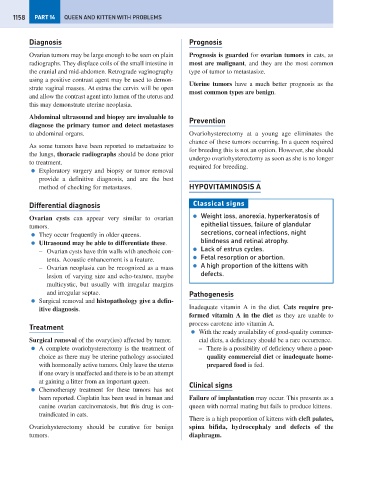Page 1166 - Problem-Based Feline Medicine
P. 1166
1158 PART 14 QUEEN AND KITTEN WITH PROBLEMS
Diagnosis Prognosis
Ovarian tumors may be large enough to be seen on plain Prognosis is guarded for ovarian tumors in cats, as
radiographs. They displace coils of the small intestine in most are malignant, and they are the most common
the cranial and mid-abdomen. Retrograde vaginography type of tumor to metastasize.
using a positive contrast agent may be used to demon-
Uterine tumors have a much better prognosis as the
strate vaginal masses. At estrus the cervix will be open
most common types are benign.
and allow the contrast agent into lumen of the uterus and
this may demonstrate uterine neoplasia.
Abdominal ultrasound and biopsy are invaluable to Prevention
diagnose the primary tumor and detect metastases
to abdominal organs. Ovariohysterectomy at a young age eliminates the
chance of these tumors occurring. In a queen required
As some tumors have been reported to metastasize to
for breeding this is not an option. However, she should
the lungs, thoracic radiographs should be done prior
undergo ovariohysterectomy as soon as she is no longer
to treatment.
required for breeding.
● Exploratory surgery and biopsy or tumor removal
provide a definitive diagnosis, and are the best
method of checking for metastases. HYPOVITAMINOSIS A
Differential diagnosis Classical signs
Ovarian cysts can appear very similar to ovarian ● Weight loss, anorexia, hyperkeratosis of
tumors. epithelial tissues, failure of glandular
● They occur frequently in older queens. secretions, corneal infections, night
● Ultrasound may be able to differentiate these. blindness and retinal atrophy.
– Ovarian cysts have thin walls with anechoic con- ● Lack of estrus cycles.
tents. Acoustic enhancement is a feature. ● Fetal resorption or abortion.
– Ovarian neoplasia can be recognized as a mass ● A high proportion of the kittens with
lesion of varying size and echo-texture, maybe defects.
multicystic, but usually with irregular margins
and irregular septae. Pathogenesis
● Surgical removal and histopathology give a defin-
itive diagnosis. Inadequate vitamin A in the diet. Cats require pre-
formed vitamin A in the diet as they are unable to
process carotene into vitamin A.
Treatment
● With the ready availability of good-quality commer-
Surgical removal of the ovary(ies) affected by tumor. cial diets, a deficiency should be a rare occurrence.
● A complete ovariohysterectomy is the treatment of – There is a possibility of deficiency where a poor-
choice as there may be uterine pathology associated quality commercial diet or inadequate home-
with hormonally active tumors. Only leave the uterus prepared food is fed.
if one ovary is unaffected and there is to be an attempt
at gaining a litter from an important queen. Clinical signs
● Chemotherapy treatment for these tumors has not
been reported. Cisplatin has been used in human and Failure of implantation may occur. This presents as a
canine ovarian carcinomatosis, but this drug is con- queen with normal mating but fails to produce kittens.
traindicated in cats.
There is a high proportion of kittens with cleft palates,
Ovariohysterectomy should be curative for benign spina bifida, hydrocephaly and defects of the
tumors. diaphragm.

